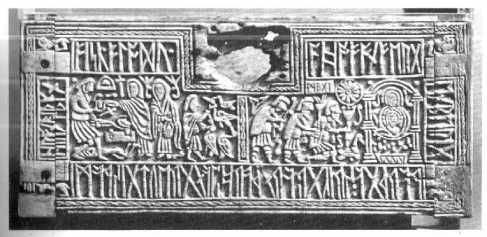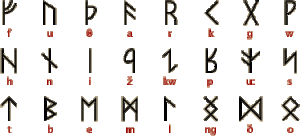A History of Runic Alphabets in Britain
by laurnmacsween
Following our lecture on the birth of symbolic language – a fascinating and massive area of visual history – I chose to focus on researching the history of Anglo-Saxon Runic Alphabets.
The alphabet we know today was not the first written form the English language took. First came ‘futhorc‘ – an Anglo-Saxon runic alphabet that was used throughout the 6th to 10th century, disappearing from use after the 1066 Norman Conquest.
 A panel from Franks Casket, an Anglo-Saxon chest discovered in the 19th Century with Futhorc Rune carvings making up the border.
A panel from Franks Casket, an Anglo-Saxon chest discovered in the 19th Century with Futhorc Rune carvings making up the border.
To me, runes appear mystical. Perhaps this opinion comes from their intertwining history with pagan religion and culture – runes are still to this day being used in the practice of Wicca. There is also something appealing by their angular style, possibly stemming from having to carve text into rock and wood and as such a fluid and cursive form wouldn’t have lend itself to scribing quickly and easily. Interestingly, in the short time that runes were in use in England the number of characters shot up from 26 to 33. I find this very peculiar considering we only use 26 letters in our modern alphabet, I can only wonder what they used the other 7 characters for!
There are several theories that attempt to explain the introduction of Futhorc runes to Anglo-Saxon England – arguing whether they were developed on English soil or simply brought over from Scandinavia. As of yet, no one argument has had enough substantial evidence to be considered concrete. Regardless, we know that runes find their origin in north-west Europe – having being used from AD 150 to document Germanic languages. Runes would later be developed for use with Scandinavian (Futhark) and Anglo-Saxon (Futhorc) languages.
An example of the futhorc alphabet, very angular and tall
These runic alphabets can find their parentage in the Phoenician and Cuneiform systems of writing – as does our modern English alphabet and nearly every other alphabet still in use today.
Created in 700 BC after Rome adopted the Greek alphabet and introduced to Britain by Christian missionaries in the 7th cenutry – the Latin alphabet quickly began replacing futhorc as the writing-form of choice. By 1066, with new influences from the incoming Norman invaders and old influences from the missionaries of Rome, the Latin Alphabet had a monopoly as the written form of English. As such futhorc runes had become archaic, only of interest to the antiquarian’s of the day.
REFERENCES:
Melissa (2013) Today I Found Out: The Origin of the English Alphabet
Cheng, L.T. The Evolution of English Writing System: A Review of Spelling Reform
Omniglot
http://www.omniglot.com/writing/futhorc.htm
Ancient Scripts: Futhark
http://www.ancientscripts.com/futhark.html
Stormene (2007) Beginning to Understand Runes: A Rune Primer
http://www.wyrdwords.vispa.com/heathenry/runeprim.html#wherefrom1


[…] A History of Runic Alphabets in Britain (laurenmacsweencdc.wordpress.com) […]